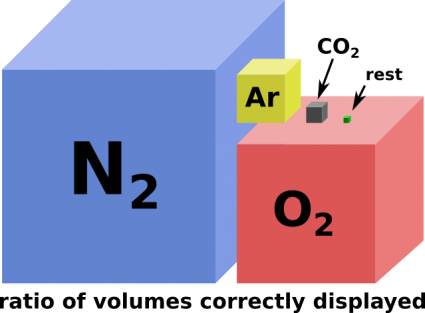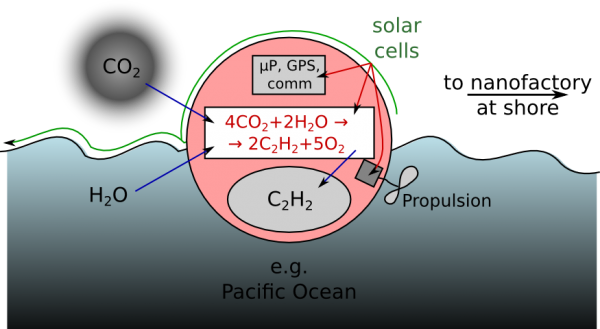Carbon dioxide collector
Template:Questionable article quality
[todo: split off makro and self replicating aspect from this page - distribute to subpages of Mobile robotic device ] [todo: tackle size and mobility decisions ]
Contents
Usage for the removal of CO2 from the atmosphere
Such devices do not need and should not be able to do self replication. Making such devices macroscopic and seaborne seems to be a better alternative. It makes handling them easier (even collectible by hand) allows for more control and less environmental spill. See: mobile carbon dioxide collector buoy. Locating solar cells for CO2 recuperation sparsely distributed in the air or on the sea instead of placing them concentrated in one place on the ground may be good for environmental (no paveover) and political reasons.
- Carbon extraction must stop at a certain level - otherwise all plants on earth are in severe danger.
- Every conscientously designed airbourn microship must care about its fate after their end of service.
Water
Seaborne air using ships of easy handlable size like mobile carbon dioxide collector buyos have the potential to fulfill the global energy needs and remove the the excess CO2 that had accumulated due to burning of fossile fuels along with other unwanted gasses of industrial origin.
Swimming units have the benefit of easier access to wind power and easier propulsion. They can easily be kept stationary.
Air
Micro airships:
- have a very lightweight bubble as main body in a size range between 10um and 100.000um
- use depending on size thermal heating or hydrogen for lift
- use their surface for harvesting of solar energy
- are capable of water capture and splitting for compensation of hydrogen diffusion loss
- may be capable of carbon dioxide capture ond splitting
- may be capable of self replication
- may (if malicious) create some nasty gasses
Questions
To investigate: If replicative how fast could they replicate (doubling time) depending on their diameter?
What is the limiting factor: solar-power for hydrogen generation, diluteness of CO2 or something else?
To investigate: Can they be made to actively propel themselves? Their high volume to mass ratio makes this rather difficult when there's even the slightest bit of wind. Flattening the bubbles drops the aerodynamic resistance significantly.
To investigate: AP manufactured solar cells & mechanosynthetic carbon dioxide splitting
Alternate forms
For swimming ones - micro ships - essentially the same reasoning applies. They need only plain air as lifting medium must be sturdier can use the wind for propulsion and are easier to collect manually (skimming) if something goes wrong.
Extraterrestrial application
- usage in Gas giant atmospheres
- usage on Venus
Related
- Josh Hall's high altitude mirror bubble concept (not necessarily handling atmospheric gasses) [todo: add video link]
- Mobile mesoscale robotic devices "nanobots"
- Mobile nanoscale robotic devices "microbots"
Usage as sentinel
Watching out for malicious micro ships. If they have the same size as the agressor ships they may be most effective but then they may become a problem themselves.
- skysweepwers (term coined by J. Storrs Hall)

